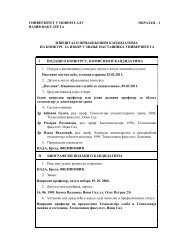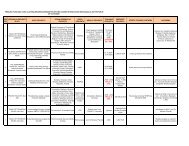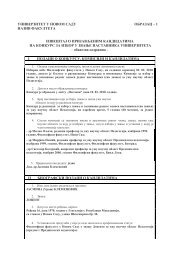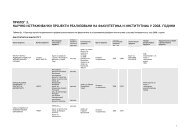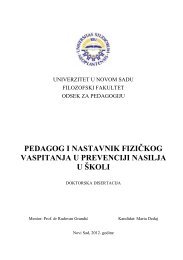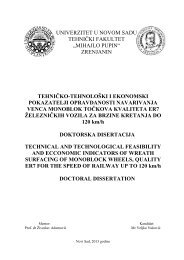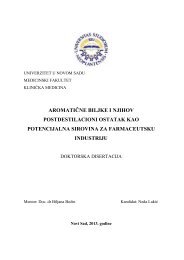Intercultural competence as an aspect of the communicative ...
Intercultural competence as an aspect of the communicative ...
Intercultural competence as an aspect of the communicative ...
You also want an ePaper? Increase the reach of your titles
YUMPU automatically turns print PDFs into web optimized ePapers that Google loves.
is import<strong>an</strong>t is to see oneself able to ‘walk in <strong>the</strong> o<strong>the</strong>r's mocc<strong>as</strong>ins’ (p. 5). The model<br />
purports that intercultural behaviour is successful when seen to be so in <strong>the</strong> eyes <strong>of</strong> a<br />
person from <strong>the</strong> target culture which should make learners aware <strong>of</strong> o<strong>the</strong>rs’ feelings.<br />
Similarly to Ruben’s model, this one also relies on three domains – cognitive, affective<br />
<strong>an</strong>d behavioural to explain intercultural encounters. Possible drawbacks <strong>of</strong> <strong>the</strong> model are<br />
that <strong>the</strong> application appears to be culture-specific, <strong>an</strong>d to be limited to sojourners (Beamer<br />
1992).<br />
Bennett’s Developmental Model <strong>of</strong> <strong>Intercultural</strong> Sensitivity<br />
Bennett (1993) <strong>of</strong>fered a framework for <strong>the</strong> conceptualization <strong>of</strong> IC dimensions in<br />
his Developmental Model <strong>of</strong> <strong>Intercultural</strong> Sensitivity (DMIS). Bennett sees intercultural<br />
sensitivity <strong>as</strong> ‘<strong>the</strong> construction <strong>of</strong> reality <strong>as</strong> incre<strong>as</strong>ingly capable <strong>of</strong> accommodating<br />
cultural difference that constitutes development’ (Bennett 1993: 24). For Bennett,<br />
learning me<strong>an</strong>s <strong>the</strong> integration <strong>of</strong> <strong>the</strong> <strong>as</strong>sumptions, values, <strong>an</strong>d beliefs (<strong>the</strong> invisible<br />
elements) <strong>of</strong> <strong>an</strong>o<strong>the</strong>r culture into one’s own world view. Therefore, <strong>as</strong> a consequence, one<br />
would be able to adapt personal behaviour (<strong>the</strong> visible) to <strong>the</strong> norms <strong>of</strong> <strong>the</strong> target culture.<br />
As Bennett believes that objective culture is <strong>of</strong> limited value for intercultural<br />
communication, he situates <strong>the</strong> model in <strong>the</strong> domain <strong>of</strong> subjective culture, stating that<br />
underst<strong>an</strong>ding objective culture ‘may create knowledge, but might not generate<br />
<strong>competence</strong>’ (Bennett 1998: 3).<br />
The DMIS constitutes a process through which one goes in moving along a<br />
continuum from more ethnocentric stages to more ethnorelative ones, with potential for<br />
more sophisticated intercultural experience. ‘The DMIS <strong>as</strong>sumes that construing cultural<br />
difference c<strong>an</strong> become <strong>an</strong> active part <strong>of</strong> one’s worldview’, which could lead to a better<br />
underst<strong>an</strong>ding <strong>of</strong> one’s own culture, <strong>as</strong> well <strong>as</strong> o<strong>the</strong>r cultures, ‘<strong>an</strong>d <strong>an</strong> incre<strong>as</strong>ed<br />
<strong>competence</strong> in intercultural relations’ (Hammer et al. 2003: 423). Therefore, this model is<br />
not a descriptive one, but a model in which ‘ch<strong>an</strong>ges in knowledge, attitudes or skills are<br />
taken <strong>as</strong> m<strong>an</strong>ifestations <strong>of</strong> ch<strong>an</strong>ges in <strong>the</strong> underlying worldview’ (Bennett 2004: 75). In<br />
terms <strong>of</strong> teaching ICC this is import<strong>an</strong>t because training is not aimed ‘at <strong>an</strong>y particular<br />
knowledge, attitude ch<strong>an</strong>ge or skill acquisition’ (ibid).<br />
Bennett’s six-stage model <strong>of</strong> learning to perceive <strong>an</strong>d work with cultural<br />
differences comprises <strong>of</strong> six stages. The stages are <strong>the</strong>n sub-grouped into ethnocentric<br />
(<strong>the</strong> first three) <strong>an</strong>d ethnorelative (<strong>the</strong> l<strong>as</strong>t three).<br />
76



